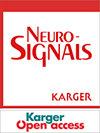Stroke increases g protein-coupled estrogen receptor expression in the brain of male but not female mice.
Q1 Medicine
引用次数: 53
Abstract
The novel estrogen receptor, G protein-coupled estrogen receptor (GPER, previously named GPR30), is widely distributed throughout the male and female brain and, thus, could potentially play a role in estrogen-mediated neuroprotective effects in diseases such as stroke. We hypothesized that GPER distribution and expression in the brain of male, intact female, and ovariectomized (OVX) mice is increased after 0.5 h middle cerebral artery occlusion. Using immunohistochemistry, we found that ischemia reperfusion increased GPER distribution in the peri-infarct brain regions of male mice, but surprisingly not in intact females or OVX mice. Similar differences were observed in the male and female human brain after stroke. In contrast, GPER distribution was decreased in the infarct core of all mice examined. Furthermore, GPER immunofluorescence was co-localized with the endothelial cell marker, von Willebrand factor, and the neuronal marker, NeuN. Consistent with the immunohistochemical findings, Western blot analysis showed GPER expression is only elevated in the ischemic hemisphere of male mice. Moreover, GPER mRNA expression in males was elevated at 4 h but had returned to baseline by 24 h. In conclusion, these findings indicate that GPER may be a potential therapeutic target after stroke, especially in males, in whom estrogen therapy is not feasible.中风增加了雄性小鼠大脑中g蛋白偶联雌激素受体的表达,而雌性小鼠没有。
这种新的雌激素受体,G蛋白偶联雌激素受体(GPER,以前命名为GPR30)广泛分布于男性和女性的大脑中,因此可能在中风等疾病中发挥雌激素介导的神经保护作用。我们假设GPER在雄性、完整雌性和去卵巢小鼠(OVX)大脑中的分布和表达在大脑中动脉闭塞0.5 h后增加。利用免疫组织化学,我们发现缺血再灌注增加了GPER在雄性小鼠梗死周围脑区域的分布,但令人惊讶的是,在完整的雌性或OVX小鼠中没有。中风后,在男性和女性的大脑中也观察到类似的差异。相比之下,GPER分布在所有小鼠的梗死核心减少。此外,GPER免疫荧光与内皮细胞标志物血管性血友病因子和神经元标志物NeuN共定位。与免疫组化结果一致,Western blot分析显示GPER仅在雄性小鼠的缺血半球表达升高。此外,男性GPER mRNA表达在4小时时升高,但在24小时后又恢复到基线水平。总之,这些发现表明GPER可能是中风后的潜在治疗靶点,特别是在男性中,雌激素治疗是不可行的。
本文章由计算机程序翻译,如有差异,请以英文原文为准。
求助全文
约1分钟内获得全文
求助全文
来源期刊

Neurosignals
医学-神经科学
CiteScore
3.40
自引率
0.00%
发文量
3
审稿时长
>12 weeks
期刊介绍:
Neurosignals is an international journal dedicated to publishing original articles and reviews in the field of neuronal communication. Novel findings related to signaling molecules, channels and transporters, pathways and networks that are associated with development and function of the nervous system are welcome. The scope of the journal includes genetics, molecular biology, bioinformatics, (patho)physiology, (patho)biochemistry, pharmacology & toxicology, imaging and clinical neurology & psychiatry. Reported observations should significantly advance our understanding of neuronal signaling in health & disease and be presented in a format applicable to an interdisciplinary readership.
 求助内容:
求助内容: 应助结果提醒方式:
应助结果提醒方式:


